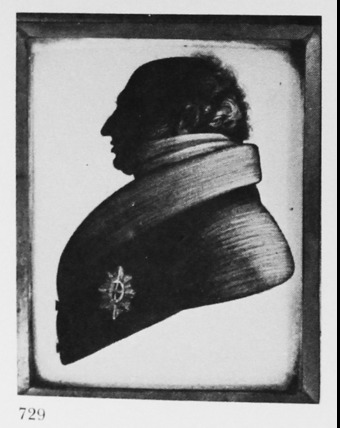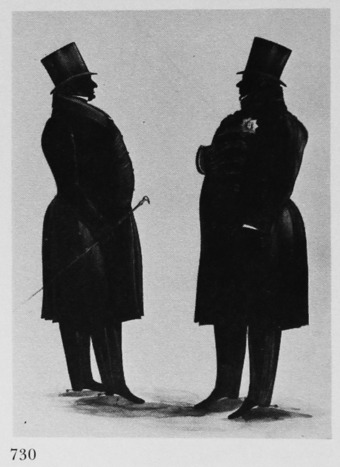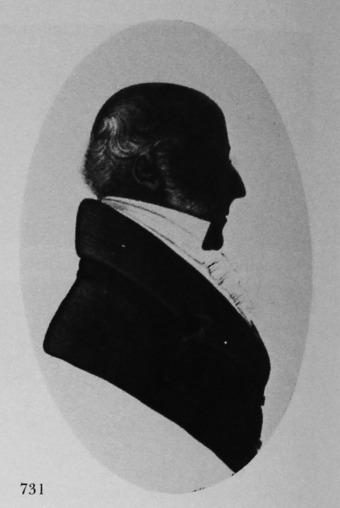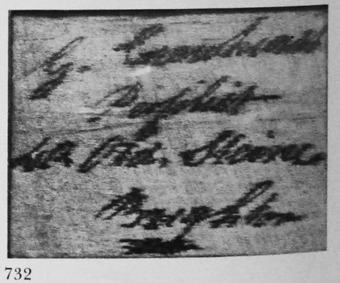Crowhurst, George 'Angelo' (McKechnie Section 2)
See also Sections, One, Five and Six
Recorded by Jackson (Dictionary), who dates his work to 1832-34. Despite the lack of evidence in local records, it is clear from several labelled or inscribed silhouettes that Crowhurst worked, at least for a few years, in Brighton.
In the National Portrait Gallery there is a double full-length silhouette of the Duke of York and George IV, apparently copied by Crowhurst from water-colour drawings executed by George Atkinson c. 1820. Crowhurst's silhouette resembles these drawings closely both in the subjects' stance and in the details of their dress (even in the spurs worn by the Duke), and it will be seen below that he often made copies of other artists' work. (Cf. Atkinson's drawing of the Duke, Section Six.)
1522
Both of Atkinson's drawings were engraved (by E. Scriven), and Crowhurst would have had easy access to the prints. His double silhouette bears on the reverse a trade label (No. 3) worded as follows:
Profiles taken and finished in Black, Bronze,
Blue-tint, cameo and colours, by
Crowhurst, 40, Old Steine, Brighton.
Profiles accurately copied, and every description
of frames for mounting of Profiles
and Miniatures.
Most of Crowhurst's labelled or inscribed silhouettes bear the address at 40 Old Steine, which had been used by George Atkinson in the early 1820s and was no doubt a convenient address for artists not working on the pier. Crowhurst may have been work-ing at this address before 1827, since it is possible that another silhouette by him (of the Duke of York, who died in 1827) may have been painted there. In the double silhouette, the Duke and George IV look younger than they would have looked in 1827, but Crowhurst was presumably copying earlier original drawings by Atkinson, as I have suggested, and may have painted his silhouette as late as the 1830s. We know that Crowhurst did work at 40 Old Steine during the 1830s. A painted bust-length profile of Sir George Clarke, Bart, physician to Queen Adelaide, signed 'George Angelo Crowhurst' and bearing the address 40 Old Steine, has recently come to light. Since Sir Charles was created a baronet on 30 September 1831, the silhouette must have been painted after that date. Sir Charles, born in 1782, appears on the silhouette to be aged between fifty and sixty, which suggests that the silhouette was painted between 1832 and 1842. Four of Crowhurst's cut silhouettes (illustrated in Chapters Five and Seven, and in Section One), representing members of the Ogle family, were taken at 40 Old Steine in July 1835.
139, 214, 215, 329.
Jackson records a portrait of an ensign, later Colonel H. J. Daniel, of the Coldstream Guards, taken at 11 Old Steine. This example, formerly owned by Coke, was sold by Sotheby and Company, London, in July 1931, together with a military group by Edouart, for £3. As no other example shows this address, Crowhurst cannot have worked there for long. Woodiwiss (British Silhouettes) mentions, but does not quote in full, an advertisement, issued from this address, which refers to work embellished in `Wedgwood blue'. I have seen no painted silhouettes of this kind signed by Crowhurst, but in my collection there are two full-length cut silhouettes of girls whose dresses are painted in this colour; both are dated 25 April 1844. I refer in the entry on Crowhurst in Section One to work of this kind, and one example (possibly by him) is illustrated. If it is such examples that are referred to in the advertisement just mentioned, then it seems that Crowhurst was probably working in Brighton as late as 1844, and that he presumably worked at 11 Old Steine later than he was working at No. 40.
The bust-length silhouette of the Duke of York is painted against black in varying depths of Chinese white and pale blue body colour. (This may well be the 'blue-tint' referred to on the trade label, No. 3, quoted above). The brushwork is of reasonable quality, and the addition of the pale blue body colour makes the piece attractive. No gum arabic appears to have been used on this or any other example attributed with certainty to Crowhurst.
The bust-length profile of Sir Charles Clarke is even better painted, in shades of greyish white against a darker background, and the hair is skilfully shown in shades of Chinese white.
The double full-length portrait of the royal brothers shows good bronzing against a black background. The brushwork is as fine as that of the artist's other painted silhouettes and as that of the painted portions of his cut work.
I have also seen, offered for sale in Brighton, full-length painted silhouettes by Crowhurst of a different type. These were a pair of silhouettes of a husband and his wife, separately framed in maple. The faces were painted in black, the hair in gold against black, the husband's clothes in shades of grey, and the wife's dress in pale blue water-colour (not in body colour). These attractive portraits, probably taken in the 1830s, may have been examples of the artist's work in colour, mentioned on Trade Label No. 3. I have seen no example of his work showing the sitter's face rendered in flesh-tints.
It is interesting to note that one example of Crowhurst's work (in the Local History Collection at Brighton Public Libraries) is mounted on the pink card favoured by Brighton artists. This is a black silhouette embellished with gold.
Although two illustrated examples are framed in papier mâché, some of Crowhurst's later work (of the late 1830s and early 1840s) might be seen in the smaller rosewood or maple frames which were thon coming into fashion.
Three trade labels are known. No. 1 (illustrated) is handwritten; it bears the address at 40 Old Steine and was used in 1835. It is on the reverse of the silhouette of Robert Ogle, illustrated in Chapter Five.
139
Trade Label No. 2, apparently in the same hand-writing, is on the reverse of the silhouette of Sir Charles Clarke. It is worded as follows:
George Angelo Crowhurst
Profilist
40, Old Steine
Brighton.
The wording of Trade Label No. 3, which bears the same address but is printed, has been quoted above. Miss D. Hare, of Brighton, tells me that she saw it on the reverses of the pair of profiles of a man and his wife referred to above, but whether it was used before or after Nos 1 and 2 is impossible to determine.
Ills. 729-732

Duke of York
Silhouette painted on card, with detail in blue body colour
Frame: papier mâché
Presumably painted not later than 1827, the year of the duke’s death. This may be an example of the ‘blue-tint’ work referred to on the artist’s Trade Label No. 3.
From the collection of the late J. C. Woodiwiss

Duke of York and George IV
Silhouette painted on card, bronzed against black; probably after prints engraved by E. Scriven after water-colours by George Atkinson
12 x 9in./395 x 229mm.
Trade Label No. 3
Compare this silhouette with Atkinson’s drawing of the duke (1522).
National Portrait Gallery, London, No. 1691 A

Sir Charles Clarke, Bart, of Dunham Lodge, Norfolk
Silhouette painted on card, in grey and Chinese white against a dark-grey background
c. 1834-36
3¼ x 2½in./83 x 64mm.
Trade Label No. 2
Frame: papier mâché, with ornamental brass surround
Inscribed on the reverse with the address 40 Old Steine. The sitter was physician to Queen Adelaide.
Elliott Levy collection

Trade Label No. 1 of George Crowhurst.
Author’s collection
